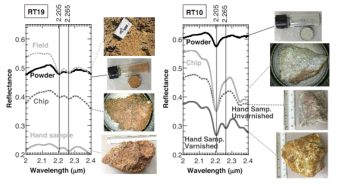2015 Annual Science Report
 Massachusetts Institute of Technology
Reporting | JAN 2015 – DEC 2015
Massachusetts Institute of Technology
Reporting | JAN 2015 – DEC 2015
Mars Analog Studies: Mineral Assemblages in Terrestrial Settings
Project Summary
It is now widely recognized that hydrated minerals, including clays, sulfates, chlorides and other salts, are important components of the martian crust. Such minerals and assemblages of minerals have the potential to record important information about past interactions between sediment, surface and groundwaters, and the atmosphere. The overarching theme of this project is to examine terrestrial analog sites to better understand how martian mineral assemblages may be used to infer these processes. Current sites include Rio Tinto, Spain and Lake Towuti, Indonesia. We have studied samples from the former and have determined that it may provide an appropriate mineralogical analog for enigmatic hydrous mineral-bearing terrains observed in Valles Marineris, Mars by orbiting spacecraft. Over the past year we have also begun to study mafic and ultramafic sediments in Lake Towuti to examine stratigraphic variations in Fe and Si-bearing mineral phases. Current results indicate these sediments and this lake system may be an appropriate mineralogical and/or chemical analog for ancient lacustrine sediments observed by the Curiosity rover in Gale Crater.
Project Progress
Outcrops of hydrated minerals are widespread across the surface of Mars, with clay minerals and sulfates being commonly identified phases. Orbitally-based reflectance spectra are often used to classify these hydrated components in terms of a single mineralogy, although most surfaces likely contain multiple minerals that have the potential to record local geochemical conditions and processes. As an example, reflectance spectra for previously identified deposits in Ius and Melas Chasma within the Valles Marineris, Mars, exhibit an enigmatic feature with two distinct absorptions be-tween 2.2 – 2.3 µm. This spectral ‘doublet’ feature is proposed to result from a mixture of hydrated minerals, although the identity of the minerals has remained ambiguous. In this project we have demonstrated that similar spectral doublet features are observed in airborne, field, and laboratory reflectance spectra of rock and sediment samples from Rio Tinto, Spain. Combined visible-near in-frared reflectance spectra and X-ray diffraction measurements of these samples reveals that the doublet feature arises from a mixture of Al-phyllosilicate (illite/muscovite) and jarosite. Analyses of orbital data from the Compact Reconnaissance Imaging Spectrometer for Mars (CRISM) shows that the martian spectral equivalents are also consistent with mixtures of Al-phyllosilicates and jarosite, where the Al-phyllosilicate may also include kaolinite and/or halloysite.
A case study for a region within Ius Chasma, Mars, demonstrates that the relative proportions of the Al-phyllosilicate(s) and jarosite vary within one stratigraphic unit as well as between stratigraphic units. The former observation suggests that the jarosite may be a diagenetic (authigenic) product and thus indicative of local pH and redox conditions, whereas the latter observation may be consistent with variations in sediment flux and/or fluid chemistry during sediment deposition. Together, these results highlight the importance of detailed geologic mapping to complement orbital identification of hydrated minerals. Though the overall mineral assemblage in these regions of Mars may be similar (e.g., clays and sulfates), the relative proportions are clearly variable and, in some cases, these variations correlate to local stratigraphic boundaries. Though Rio Tinto may provide an appropriate mineralogical analog for certain martian deposits, the apparent geologic setting of some of the martian deposits suggests the processes occurring in Rio Tinto may not always be applicable to equivalent mineral assemblages observed on Mars. The results of this work is currently under review in a paper submitted to Icarus.
A new aspect of this work is a project started in September 2015 that is evaluating sediment and rock cores from Lake Towuti, Indonesia as possible analogs for rocks examined by the Curiosity rover in Gale Crater, Mars. Sediments in Lake Towuti are sourced from mafic/ultramafic terrains and previous work has shown that the chemistry and mineralogy of these materials can be used to infer paleoclimate. We are collaborating with independently-funded colleagues that are exploring this system for non-Mars research, thereby leveraging the NAI support and allowing us to examine a new potential Mars analog site. Early analysis of the lake sediments and cores suggest chemical variations and trends that are similar to those observed by the Curiosity rover. Specifically, the redox state and mineralogical host(s) of iron vary within the lake cores, as do other important elements such as Si and Ti. Importantly, positive trends between Si and Ti are observed and are indicative of enhanced erosion in the source region. In contrast, similar trends observed in data acquired by Curiosity have been interpreted as an indicator of acid-sulfate weathering. By detailed examination of these mafic lake sediments and their post-depositional history, we seek to better understand how to relate chemistry and mineralogy to environmental processes. This work will then provide a new perspective on how to interpret chemical and mineral information for ancient lake sediments observed by Curiosity, with an emphasis on disentangling provenance and diagenetic effects.

Publications
- Kaplan, H.H., R.E. Milliken, D. Fernández-Remolar, R. Amils, K. Robertson, and A.H. Knoll (2015), Orbital evidence for clay and acidic sulfate assemblages on Mars and mineralogical analogs from Rio Tinto, Spain, 46th Lunar and Planetary Science Conference, Abstract #1958
- Kaplan, H.H., R.E. Milliken, D. Fernández-Remolar, R. Amils, K. Robertson, and A.H. Knoll (2015), Orbital evidence for clay and acidic sulfate assemblages on Mars and mineralogical analogs from Rio Tinto, Spain, Fall Meeting of the AGU, Abstract #P23C-04.
-
PROJECT INVESTIGATORS:
-
PROJECT MEMBERS:
Hannah Kaplan
Co-Investigator
Andrew Knoll
Co-Investigator
Ricardo Amils
Collaborator
David Fernández Remolar
Collaborator
-
RELATED OBJECTIVES:
Objective 2.1
Mars exploration.
Objective 4.1
Earth's early biosphere.
Objective 4.3
Effects of extraterrestrial events upon the biosphere
Objective 6.1
Effects of environmental changes on microbial ecosystems

